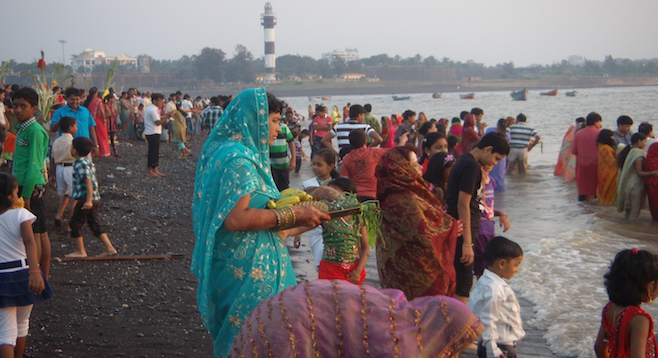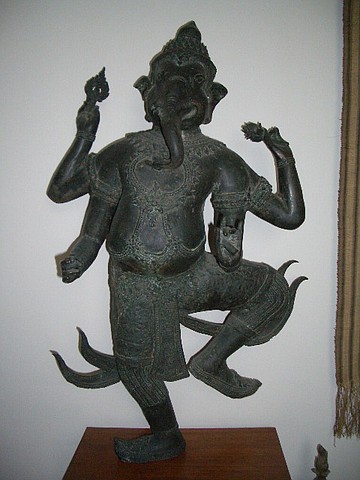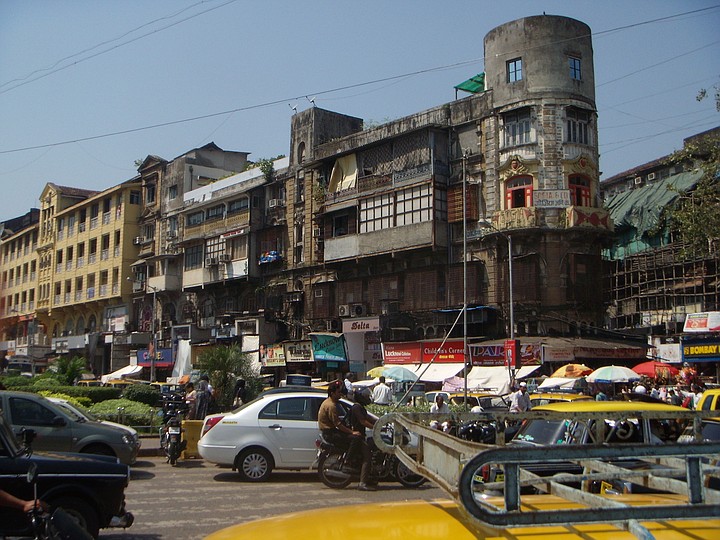 Facebook
Facebook
 X
X
 Instagram
Instagram
 TikTok
TikTok
 Youtube
Youtube

In India’s Vedic prehistory, the son of Shiva and Parvati began his journey toward immortality when his father mistakenly lopped off his head with a sword, and upon realizing his mistake, replaced his son’s head with one of a passing elephant. That son goes by the names of Ganesh and Ganapati. He is commonly depicted throughout India as chubby, smiling and a little mischievous.

Ganesh’s devotees ascribe to him the ability to grant wisdom and wealth. This makes him probably the most popular deity in the Hindu pantheon. To repay Ganesh’s bounty in Mumbai (also called by its former colonial name, Bombay), every year around September, in the Hindu month of Bhadra, virtually the entire Hindu population of the city celebrates his birth in the ten-day festival of Ganesh Chaturthi.
The festival
During the Ganesh festival, devotees purchase small images for their homes, and professional craftsmen mold enormous clay images that are set up in pavilions throughout the city. On the tenth day of the holiday, or puja, all the industrial-sized clay images are loaded on flat bed trucks. The smaller ones travel in the back seat of cars or are simply carried by hand on urban railways to the beaches of the city. There, this most beneficent of gods is subjected to the annual indignity of being immersed and dissolved in the fetid waters of the Arabian Sea.
The festival actually has secular origins. It began as a way for the Indian independence movement to circumvent the British ban on public assembly during the late 19th century. But whatever its origins, the event is now a colossal celebration, and perhaps the world’s largest religion-inspired beach party.

Processions from all over Bombay commandeer the city’s already congested road system, riding upon or walking beside the doomed Ganapatis. Loud speakers shriek from the truck cabs and marchers bang drums and gongs, while orange-capped devotees on the back of the trucks shower themselves and everyone in their wake with red powder called gulal.
The most popular destination for these processions is Chowpatty Beach. It is a curved strip of sand about a kilometer long at the north end of posh Marine Drive.
On normal days, Chowpatty serves as the city’s permanent carnival site, homeless shelter and pony riding school. On puja day, though, it is ablaze with high-intensity lighting and crowded with more trucks than a major highway depot. The decibel level from the competing speakers would register between deafening and fatal. Amidst it all, thousands of families spread blankets and consume picnics.
They come to see the infinite variety of shapes, postures and personalities the Ganapati makers have brought to their art during their months of preparation. Dozens of the normal pink ones sitting in a yogic pose are brought, as well as standing ones with a benevolent hand lifted. But there are also many more worldly ones with flashing lights or festooned with coins. My favorite was a gigantic yellow god playing a sitar sitting on a blue globe.
Whatever the style of their Ganapati, however, all worshippers share one experience when they arrive at the beach. After they've lavished him with garlands and powder and presented him, according to their own preferences, with offerings of fruit and flowers. After they have performed, according to their own faith, their private devotions to him. They must all face one final unifying question: “How in god’s name are we going to get this ten-foot-tall, 500-kilogram statue off the back of this truck and down to the sea without a forklift?”
Well, don’t ask me, but somehow they all do it. People seemed to be loosely organized into truck bed crews and beach assault divisions. The guys on the truck shove and muscle the image off the back. Then the landing force, stripped to loin cloths, take it onto their shoulders and, with knees buckling like an over-ambitious weightlifter failing to finish a snatch, they stumble headlong, like a drunken centipede toward the surf, screeching, “Ganapati Bappa Morya, Ganapati Bappa Morya.”
I don’t know any Indian languages, but from the reaction of the bystanders, I believe this chant roughly translates: “Thousand pound god coming through. Move your butt or lose it – NOW!!!”
When they reach the sea, with or without a couple of bodies underfoot, they carry the Ganapati into the water and attempt to turn him flat and push out to sink and dissolve. Some don’t succeed. A poignant sight is a few of the especially buoyant and bottom-heavy ones sitting upright and floating several hundred yards from shore as if they'd begun a long journey to East Africa. I hope they made it.
The party continues until after midnight, when the last Ganapati is launched and the beach is finally returned to its indigenous homeless sleepers and fishing families. In the morning, it resembles an Indian version of New Orleans on Ash Wednesday, with flotsam of marigolds quietly washing ashore alongside undissolved elephant trunks and palm frond garlands.
The cleanup crews and scavengers go to work early and, by afternoon, the beach is back to its normal state of clutter to lie dormant for another year, while the Makers of the Gods replenish their storehouses and wait for the frenzy to renew.


In India’s Vedic prehistory, the son of Shiva and Parvati began his journey toward immortality when his father mistakenly lopped off his head with a sword, and upon realizing his mistake, replaced his son’s head with one of a passing elephant. That son goes by the names of Ganesh and Ganapati. He is commonly depicted throughout India as chubby, smiling and a little mischievous.

Ganesh’s devotees ascribe to him the ability to grant wisdom and wealth. This makes him probably the most popular deity in the Hindu pantheon. To repay Ganesh’s bounty in Mumbai (also called by its former colonial name, Bombay), every year around September, in the Hindu month of Bhadra, virtually the entire Hindu population of the city celebrates his birth in the ten-day festival of Ganesh Chaturthi.
The festival
During the Ganesh festival, devotees purchase small images for their homes, and professional craftsmen mold enormous clay images that are set up in pavilions throughout the city. On the tenth day of the holiday, or puja, all the industrial-sized clay images are loaded on flat bed trucks. The smaller ones travel in the back seat of cars or are simply carried by hand on urban railways to the beaches of the city. There, this most beneficent of gods is subjected to the annual indignity of being immersed and dissolved in the fetid waters of the Arabian Sea.
The festival actually has secular origins. It began as a way for the Indian independence movement to circumvent the British ban on public assembly during the late 19th century. But whatever its origins, the event is now a colossal celebration, and perhaps the world’s largest religion-inspired beach party.

Processions from all over Bombay commandeer the city’s already congested road system, riding upon or walking beside the doomed Ganapatis. Loud speakers shriek from the truck cabs and marchers bang drums and gongs, while orange-capped devotees on the back of the trucks shower themselves and everyone in their wake with red powder called gulal.
The most popular destination for these processions is Chowpatty Beach. It is a curved strip of sand about a kilometer long at the north end of posh Marine Drive.
On normal days, Chowpatty serves as the city’s permanent carnival site, homeless shelter and pony riding school. On puja day, though, it is ablaze with high-intensity lighting and crowded with more trucks than a major highway depot. The decibel level from the competing speakers would register between deafening and fatal. Amidst it all, thousands of families spread blankets and consume picnics.
They come to see the infinite variety of shapes, postures and personalities the Ganapati makers have brought to their art during their months of preparation. Dozens of the normal pink ones sitting in a yogic pose are brought, as well as standing ones with a benevolent hand lifted. But there are also many more worldly ones with flashing lights or festooned with coins. My favorite was a gigantic yellow god playing a sitar sitting on a blue globe.
Whatever the style of their Ganapati, however, all worshippers share one experience when they arrive at the beach. After they've lavished him with garlands and powder and presented him, according to their own preferences, with offerings of fruit and flowers. After they have performed, according to their own faith, their private devotions to him. They must all face one final unifying question: “How in god’s name are we going to get this ten-foot-tall, 500-kilogram statue off the back of this truck and down to the sea without a forklift?”
Well, don’t ask me, but somehow they all do it. People seemed to be loosely organized into truck bed crews and beach assault divisions. The guys on the truck shove and muscle the image off the back. Then the landing force, stripped to loin cloths, take it onto their shoulders and, with knees buckling like an over-ambitious weightlifter failing to finish a snatch, they stumble headlong, like a drunken centipede toward the surf, screeching, “Ganapati Bappa Morya, Ganapati Bappa Morya.”
I don’t know any Indian languages, but from the reaction of the bystanders, I believe this chant roughly translates: “Thousand pound god coming through. Move your butt or lose it – NOW!!!”
When they reach the sea, with or without a couple of bodies underfoot, they carry the Ganapati into the water and attempt to turn him flat and push out to sink and dissolve. Some don’t succeed. A poignant sight is a few of the especially buoyant and bottom-heavy ones sitting upright and floating several hundred yards from shore as if they'd begun a long journey to East Africa. I hope they made it.
The party continues until after midnight, when the last Ganapati is launched and the beach is finally returned to its indigenous homeless sleepers and fishing families. In the morning, it resembles an Indian version of New Orleans on Ash Wednesday, with flotsam of marigolds quietly washing ashore alongside undissolved elephant trunks and palm frond garlands.
The cleanup crews and scavengers go to work early and, by afternoon, the beach is back to its normal state of clutter to lie dormant for another year, while the Makers of the Gods replenish their storehouses and wait for the frenzy to renew.
Comments